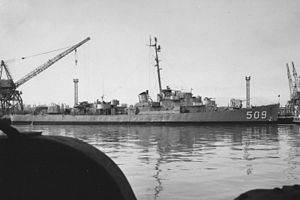- USS Formoe (DE-509)
-

USS Formoe DE-509 1956Career (US) 
Laid down: 3 January 1944 Launched: 2 April 1944 Commissioned: 5 October 1944 Decommissioned: 27 May 1946 In service: 27 June 1951 Out of service: 7 February 1957 Struck: 1 October 1968 Fate: Loaned to Portugal 7 February 1957 General characteristics Displacement: 1,350/1,745 tons Length: 306 ft (93 m) overall Beam: 36 ft 10 in (11.23 m) Draft: 13 ft 4 in (4.06 m) maximum Propulsion: 2 boilers, 2 geared turbine engines, 12,000 shp, 2 screws Speed: 24 knots (44 km/h) Range: 6,000 nm @ 12 knots (22 km/h) Complement: 14 officers, 201 enlisted Armament: 2-5"/38, 4 (2 × 2) 40 mm AA, 10-20 mm AA, 3-21" torpedo tubes, 1 Hedgehog, 8 depth charge projectors, 2 depth charge tracks USS Formoe (DE-509) was a John C. Butler-class destroyer escort acquired by the U.S. Navy during World War II. The primary purpose of the destroyer escort was to escort and protect ships in convoy, in addition to other tasks as assigned, such as patrol or radar picket. Post-war she proudly returned home with two battle stars to her credit.
Formoe (DE-509) was named in honor of Clarence Melvin Formoe, born 25 January 1909 in Seattle, Washington. Formoe served in the Naval Reserve from 25 November 1930, on active duty after 1 July 1941. While serving in the Air Scouting Force at the Naval Air Station, Kaneohe Bay, Oahu, Aviation Machinist's Mate First Class Formoe was killed in action during the Japanese attack of 7 December 1941. He was posthumously commended for his efforts to repel the attack in utter disregard of his own safety.
Formoe was launched 2 April 1944 by Federal Shipbuilding and Dry Dock Co., Newark, New Jersey; sponsored by Mrs. A. L. Bolshazy; and commissioned 5 October 1944, Lieutenant Commander J. C. Spencer in command.
Contents
World War II Pacific Theatre operations
Formoe arrived at Manus from the U.S. East Coast 15 January 1945, and ten days later sailed for Morotai to join a troop convoy bound with reinforcements for Lingayen. She entered Lingayen Gulf 10 February, and for the next month and a half operated in the Philippines, guarding minecraft and exploding the mines they swept in Baler Bay and Casiguran Sound, and sailing as escort from Lingayen to Leyte. From 21 March to 30 March, Formoe patrolled off Panay in a picket line covering landings there, then continued her Philippine escort duty, making one voyage to Manus to bring landing craft north.
The escort departed Subic Bay 18 April 1945 to stage at Morotai for the invasion of Borneo. She arrived at Tarakan 1 May escorting the amphibious force, and from 3 May to 30 May off Borneo, acting as headquarters ship for Captain Charles Gray, the officer commanding all naval activities at Tarakan. In addition to driving off several Japanese air attacks, she fired in four separate shore bombardments to support the troops advancing ashore. Between 2 June and the close of the war, Formoe ranged widely on escort duty, calling at Leyte, Hollandia, Ulithi, Manila, and Okinawa.
End-of-war operations
At Manila at the close of hostilities, she began occupation duty with a return voyage to Okinawa, then served as escort for the flagship of Fleet Air Wing 1 for most of the remainder of her career, calling at Shanghai and Hong Kong, as well as in Tokyo Bay. She returned to San Francisco, California, 20 January 1946, and was decommissioned and placed in reserve at San Diego, California, 27 May 1946.
Reactivated during Korean War
Recommissioned 27 June 1951, Formoe sailed from San Diego, California, 5 October 1951 for Newport, Rhode Island, her home port. For the next year she trained in New England and Caribbean waters, then served from October to December as training ship at the Fleet Sonar School, Key West, Florida. She had similar duty the next autumn, otherwise continuing her east coast and Caribbean operations until sailing from Newport 13 September 1954 to rejoin the U.S. Pacific Fleet.
From February through June 1955, and again from October 1955 to March 1956, Formoe carried out tours of duty in the Far East, taking part in hunter-killer operations and serving as station ship at Hong Kong.
Final decommissioning
Upon her return she prepared for foreign transfer at San Francisco, California, where she was decommissioned 7 February 1957 and transferred the same day to Portugal under the Mutual Defense Assistance Program. She served in the Portuguese Navy as Diogo-Cão F-333. She was eventually sold to Portugal in December 1968.
Military awards
Formoe received two battle stars for World War II service.
See also
References
This article includes text from the public domain Dictionary of American Naval Fighting Ships. The entry can be found here.
External links
Categories:- John C. Butler class destroyer escorts
- World War II frigates and destroyer escorts of the United States
- Ships built in New Jersey
- 1944 ships
- United States Navy ships transferred to the Portuguese Navy
Wikimedia Foundation. 2010.
